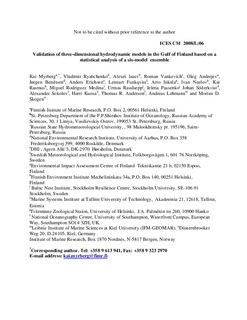| dc.description.abstract | Six three-dimensional hydrodynamic models were compared in their simulations of the hydrographic features of the Gulf of Finland in the Baltic Sea in the summer-autumn period of 1996. Validation was undertaken using more than 300 vertical hydrographic profiles of salinity and temperature. The analysis of model performance, including ensemble averaging of the results, was undertaken with a view to assessing the potential utility of the models in reproducing the physics of the Baltic Sea accurately enough to serve as a basis for accurate simulations of biogeochemistry once ecosystem models are incorporated.
The overall performance of the models was generally satisfactory. However, the comparison between observations and ensemble simulations indicated some drawbacks in the parameterization of vertical mixing. Also the choice of initial conditions, surface forcing and differences between real topography and that one used in the models influenced the differences between observations and model results. Looking from another perspective we can state that the accuracy of the present hydrodynamic models determines the upper limit for that of ecosystem models. In turn, the reliability of the hydrodynamic models depends on the physical forcing which is not always as accurate as one may expect. In the future further development of hydrodynamic models is needed in the following areas: the description of vertical mixing and advection should be improved, description of forcing functions including bathymetry, atmospheric forcing, river discharge and boundary conditions should be refined. Additionally more work should be focused on model inter comparisons to clarify the reasons behind the differences in between the models and between model and data
Keywords: Baltic Sea, hydrodynamics, modeling, inter-comparison, statistical analysis | no_NO |
